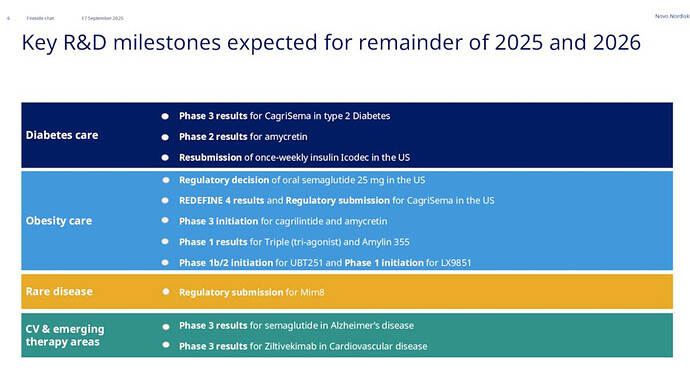Novo Nordisk presents phase 3 data for next-generation amylin cagrilintide, leading to advancement into dedicated clinical programme
2025-09-16 12:00:47
- Positive results show that the average weight loss was 12.5 kg (11.8% body weight reduction) with cagrilintide compared to 2.5 kg (2.3%) with placebo, after 68 weeks*1,2
- Cagrilintide was well-tolerated, with the most common side effects being gastrointestinal; these were mainly transient and mild to moderate in severity1
- Based on these results, Novo Nordisk will advance cagrilintide into the dedicated RENEW phase 3 clinical programme later this year
Bagsværd, Denmark, 16 September 2025 – Novo Nordisk today presented data from a sub-analysis of the phase 3 REDEFINE 1 trial at the European Association for the Study of Diabetes (EASD) congress 2025 from 15–19 September in Vienna, Austria. This sub-analysis evaluated the efficacy and safety of once-weekly cagrilintide 2.4 mg monotherapy, plus lifestyle intervention, for adults with obesity or overweight and a weight‑related comorbidity without diabetes.1 Cagrilintide is a long-acting amylin analogue that mimics the naturally occurring hormone amylin and works differently than currently approved GLP-1-based treatments for weight loss.1,2 These findings represent the first and only phase 3 clinical trial data with an investigational long-acting amylin analogue monotherapy for the management of obesity.1
In REDEFINE 1, cagrilintide provided clinically meaningful weight loss, with an average body weight reduction of 11.8% compared to 2.3% with placebo after 68 weeks, if all participants adhered to treatment.*1 Additionally, around 1 in 3 participants (31.6%) receiving cagrilintide achieved ≥15% weight loss, compared to around 1 in 20 participants (4.7%) receiving placebo.*1,2
Cagrilintide was well-tolerated, with the most common side effects being gastrointestinal, including nausea, vomiting, diarrhoea and constipation. These were mainly temporary and mild to moderate. Nausea led to permanent discontinuation of cagrilintide in 1.0% of participants, compared with 0.1% of participants for placebo.1 “These data highlight the exciting potential of cagrilintide to offer an alternative approach for people to lose weight, achieve health-related outcomes and manage their obesity, including a favourable tolerability profile,” said lead investigator Timothy Garvey, MD, professor of medicine and director of the Diabetes Research Center at the University of Alabama at Birmingham. “Like other chronic diseases, we need a range of treatment options to address the individual needs of people with obesity, such as their own specific response to treatment.”
When evaluating the treatment effect regardless of adherence,** average weight loss with cagrilintide was 11.5% compared to 3.0% with placebo after 68 weeks. Additionally, 31.0% of participants achieved ≥15% weight loss with cagrilintide compared to 5.2% with placebo.**1
The dedicated phase 3 RENEW programme will investigate the efficacy and safety of cagrilintide in people with obesity or overweight and is due to start in Q4 2025.
“Our current and future therapies aim to help people with obesity achieve meaningful weight loss and broader health benefits. With the global scale of obesity, further scientific innovation and therapy options are needed to meet every individual’s needs and preferences,” said Martin Holst Lange, chief scientific officer and executive vice president of Research & Development at Novo Nordisk. “In our clinical trials, cagrilintide has provided substantial weight loss, in a distinct manner compared to approved obesity medications, and appears well-tolerated. We’re excited that these data, the first phase 3 data of a next-generation amylin therapy, show promise and we look forward to further investigating cagrilintide’s potential in the dedicated phase 3 RENEW programme.”
- Based on the trial product estimand; estimated treatment effect if all participants adhered to treatment.
** Based on the treatment policy estimand; treatment effect regardless of treatment adherence.
Ser teknisk spennende ut igjen


